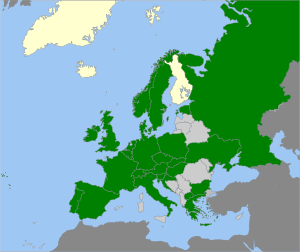Oak cystid bark fungus
| Oak cystid bark fungus | ||||||||||||
|---|---|---|---|---|---|---|---|---|---|---|---|---|

The peniophora quercina ( Peniophora quercina ) associated with a Schwielenflechte ( Physcia sp.) And the ordinary Gelbflechte ( Xanthoria parietina ) |
||||||||||||
| Systematics | ||||||||||||
|
||||||||||||
| Scientific name | ||||||||||||
| Peniophora quercina | ||||||||||||
| ( Pers .: Fr. ) Cooke |
The inedible oak cystid bark mushroom ( Peniophora quercina ) is a type of mushroom from the cystid bark family . The reddish to violet-gray, crust-like fruiting bodies appear all year round on dead oak, more rarely on beech branches or twigs.
features
Macroscopic features
The oak-cystid bark fungus forms initially attached , crust -like ( resupinate ) fruiting bodies, which grow as crusty coatings under the branches. Soon they stand out from the edge and the fruiting bodies bend up slightly to the side. The hymenium is pale red, flesh-brown to gray-red and moist purple-gray in color. It can swell up to about 2 mm thick and then appears slightly glassy-waxy. The surface is smooth or slightly bumpy. When it is dry, the fruit bodies become cracked, crusty and brittle and are then only 0.2–0.5 mm thick.
Microscopic features
The cylindrical and slightly curved spores are smooth and transparent ( hyaline ) and measure 9–12 × 3–4 µm. Gloeocystids are absent; instead, pointed, thin-walled and encrusted cystids are found .
Ecology and diffusion
The oak-cystid bark fungus occurs in all domestic deciduous and mixed forest communities in which oaks occur naturally or have been mixed in. It is particularly common in red beech and oak forests, as well as in forests, parks, gardens and other plantings. The fungus lives gregariously on the bark of dead, attached or hanging, but also fallen branches and twigs. The fruiting bodies can be found all year round. The oak cystid bark fungus is involved from the initial to the late optimal phase of wood rot. Its substrate consists of almost 90% oak and almost 9% red beech wood, the rest is made up of other deciduous trees.
distribution
The fungus is found in North America (Mexico, USA), Asia (Iran, North India, Tibet, Japan, South Korea), North Africa (Morocco) and Europe. The species is boreosubtropical to temperate (subboreal) and mainly distributed holarctic . The fungus occurs in almost all of Europe and is widespread in European oak areas. Only in Finland does it seem to be missing. In the north, its area boundary is in southern Scandinavia, where it advances north to around the 60th parallel.
In Germany, the oak-cystid bark fungus is widespread and regionally dense from the coast to the Alps. However, there are obvious gaps. In addition to the natural loosening areas in the montane coniferous forest areas of southern Germany, there is a larger area gap in North Rhine-Westphalia on the right bank of the Rhine, which already includes considerable parts of Lower Saxony, western Hesse and the northern Rhineland.
meaning
The oak cystid bark mushroom is not an edible mushroom.
swell
- Paul Kirk: Peniophora quercina. In: Species Fungorum. Retrieved January 9, 2014 .
- Peniophora quercina. In: MycoBank.org. International Mycological Association, accessed January 9, 2014 .
Individual evidence
- ↑ a b Marcel Bon : Parey's book of mushrooms . Kosmos, Stuttgart 2005, ISBN 3-440-09970-9 , pp. 322 (English: The mushrooms and tools of Britain and Northwestern Europe . Translated by Till R. Lohmeyer).
- ^ A b Hans E. Laux: The new cosmos mushroom atlas . 1st edition. Kosmos, Stuttgart 2002, ISBN 3-440-07229-0 , pp. 218 .
- ^ A b c German Josef Krieglsteiner (Ed.): Die Großpilze Baden-Württemberg . Volume 1: General Part. Stand mushrooms: jelly, bark, prick and pore mushrooms. Ulmer, Stuttgart 2000, ISBN 3-8001-3528-0 , p. 281.
- ↑ Cvetomir M. Denchev & Boris Assyov: Checklist of the larger basidiomycetes in Bulgaria . In: Mycotaxon . tape 111 , 2010, ISSN 0093-4666 , p. 279–282 ( online [PDF]).
- ↑ a b Worldwide distribution of Peniophora quercina. (No longer available online.) In: GBIF Portal / data.gbif.org. Archived from the original on January 12, 2014 ; accessed on January 10, 2014 . Info: The archive link was inserted automatically and has not yet been checked. Please check the original and archive link according to the instructions and then remove this notice.
- ^ GI Zervakis, E. Polemis, DM Dimou: Mycodiversity studies in selected ecosystems of Greece: III. Macrofungi recorded in Quercus forests from southern Peloponnese. In: cybertruffle.org.uk (Ed.): Mycotaxon . Vol 84, 2002, pp. 141-162 ( online ).
- ↑ Jean-Pierre Prongué, Rudolf Wiederin, Brigitte Wolf: The fungi of the Principality of Liechtenstein . In: Natural history research in the Principality of Liechtenstein . Vol. 21. Vaduz 2004 ( online [PDF]).
- ^ S. Petkovski: National Catalog (Check List) of Species of the Republic of Macedonia . In: Acta Botanica Croatica . 2009 ( PDF, 1.6MB ( Memento from February 15, 2010 in the Internet Archive ) [accessed January 10, 2014]). National Catalog (Check List) of Species of the Republic of Macedonia ( Memento of the original from February 15, 2010 in the Internet Archive ) Info: The archive link has been inserted automatically and has not yet been checked. Please check the original and archive link according to the instructions and then remove this notice.
- ↑ Peniophora quercina. Pilzoek database, accessed January 10, 2014 .
- ^ TV Andrianova et al .: Peniophora quercina. Fungi of Ukraine. In: cybertruffle.org.uk. Retrieved January 10, 2014 .
